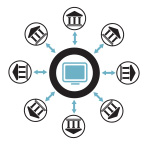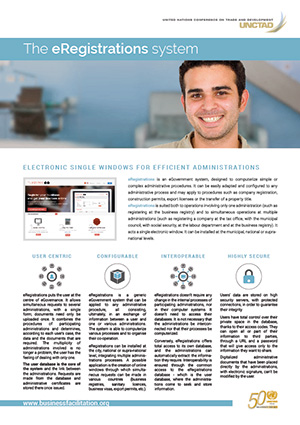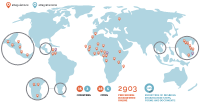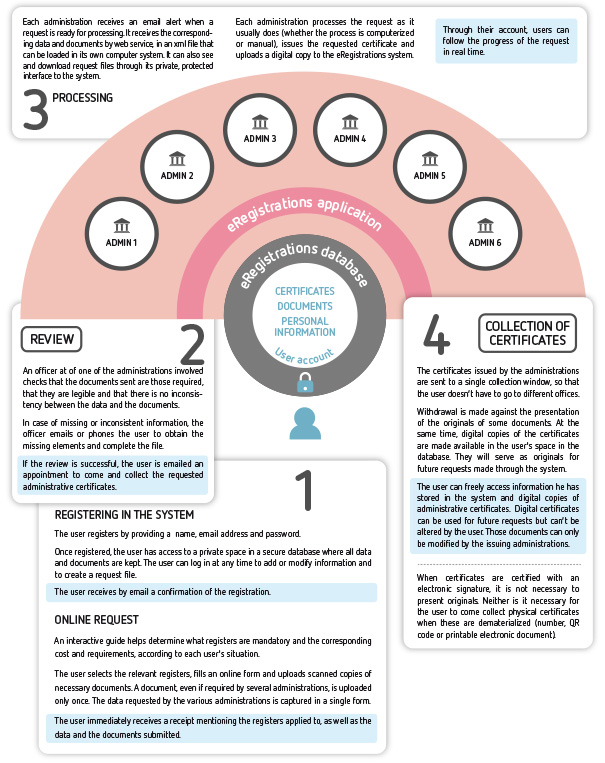transactional
electronic single windows
Computerize administrative procedures
eRegistrations is an eGovernment system, designed to computerize simple or complex administrative procedures. It can be easily adapted and configured to any administrative process and may apply to procedures such as company registration, construction permits, export licenses or the transfer of a property title.
eRegistrations is suited both to operations involving only one administration (such as registering at the business registry) and to simultaneous operations at multiple administrations (such as registering a company at the tax office, with the municipal council, with social security, at the labour department and at the business registry). It acts as a single electronic window.
It can be installed at the municipal, national or supra-national levels.

The user at the centre of electronic governance

eRegistrations allows simultaneous requests to several administrations, with a single form; documents need only be uploaded once. It combines the procedures of participating administrations and determines, according to each user's case, the data and the documents that are required. The multiplicity of administrations involved is no longer a problem, the user has the feeling of only dealing with one.
The user database is the core of the system and the link between the administrations. Requests are made from the database and administrative certificates are stored there once issued.
Interoperability with existing systems

eRegistrations doesn't require any change in the internal processes of participating administrations, nor in their computer systems. It doesn't need to access their databases. It is not necessary that the administrations be interconnected nor that their processes be computerized.
Conversely, eRegistrations offers total access to its own database, and the administrations can automatically extract the information they require. Interoperability is ensured through the common access to the eRegistrations database - which is the user database, where the administrations come to seek and store information.
Advanced security

Users' data are stored on high security servers, with protected connections, in order to guarantee their integrity.
Users have total control over their private space in the database, thanks to their access codes. They can open all or part of their information to third parties, through an URL and a password that will give access only to the information they want to share.
Digitalized administrative documents that have been placed directly by the administrations, with electronic signature, can't be modified by the user.
Configurability and adaptability

eRegistrations is a generic eGovernment system that can be applied to any administrative procedure, all consisting, ultimately, in an exchange of information between a user and one or various administrations. A complex procedure is no more than a combination of simple processes. The system is able to computerize each of the simple processes, and to organise their co-operation.
eRegistrations can be installed at the city, national or supra-national level. At all three levels, it can integrate the processes of multiple administrations. A possible application at the supra-national level is the creation of online windows through which simultaneous requests can be made in various countries (business registries, sanitary licences, business visas, export permits, etc.).
Procedures must first be documented and simplified
The first phase consists in documenting, in a detailed way, the procedures which will be computerized: the steps, the administrations involved, the forms and documents required, the costs, the administrative certificates that will be issued and the legal basis.
Once clarified, procedures can be simplified, by eliminating requirements that are not relevant or legally justified. The data requested by the various administrations are grouped in a single online form. A solution is found so that payments are combined, at the cashier of one of the institutions, at a bank or online. Arrangements are made for a single location where user will collect the certificates issued by the administrations involved in the procedure. Simplification is quicker if a physical single window is already in place, but this is not indispensable.
UNCTAD can help countries clarify and simplify their administrative procedures, thanks to the eRegulations system (www.eregulations.org).
 1-4
1-4 months

From one to four months on average, depending on the complexity of procedures and on the cooperation granted by participating administrations
System configuration
The system is configured to take into account the quantity and the identity of administrations involved, the data and the documents requested by each institution, the choice of the administration that will be in charge of reviewing requests (the reviewer can vary according to the certificates that are requested), the place where certificates will be collected (also variable depending on the requests), the order in which administrations will process the requests (parallel or sequential), the text and the timing of alert messages sent to users and to administrations, and statistics which will be generated (registered users, requests initiated, requests submitted, certificates issued, average processing time per institution, etc.).
A public interface is developed, i.e. a homepage and a few additional pages (about us, contact, etc.) to present the site to the users. The public interface is tailor-made for each city, country or regional grouping.
 2-6
2-6 months

From two to six months on average, depending on the complexity of procedures
Testing and training
Tests are organized to ensure that the system adequately takes into account the information and conditions requested by each administration, that cases of refusal are correctly listed and that alert messages reach designated officers. The review module, the processing order, messages sent to users, the statistics and of the internal files follow-up modules are also checked.
Tailor-made manuals are made available to each administration and training is organised for their officers.
Testing is completed with the processing of a few real cases, in order to fine-tune the system and to validate operators’ ability in live conditions.
 1-2
1-2 months

From one to two months on average, depending on the complexity of procedures and on the cooperation granted by participating administrations








